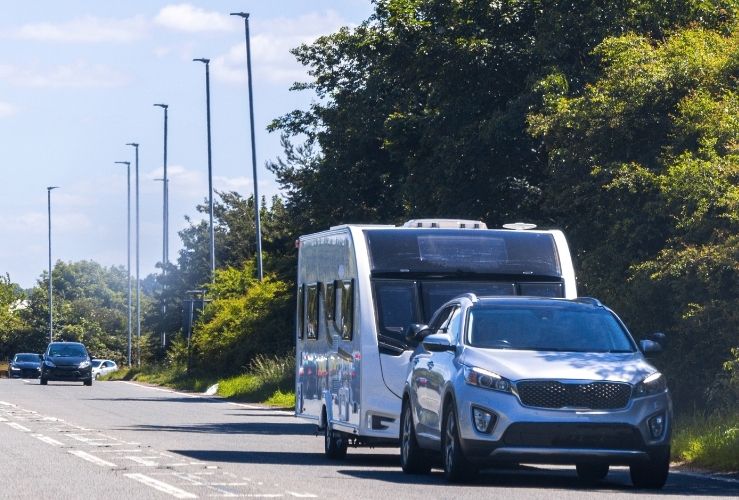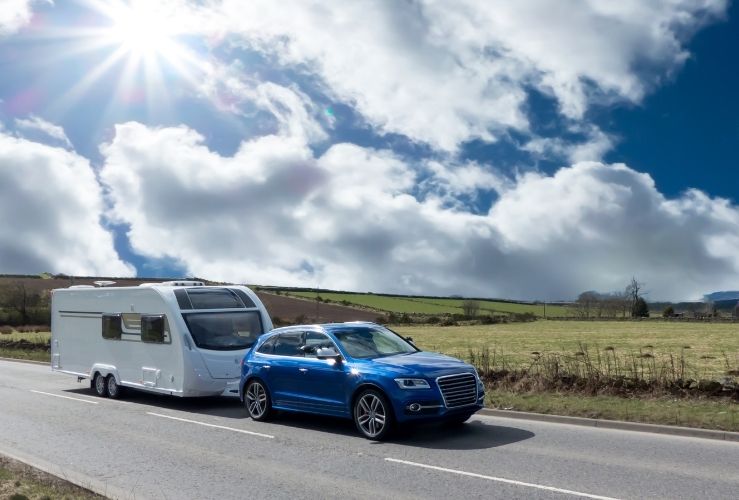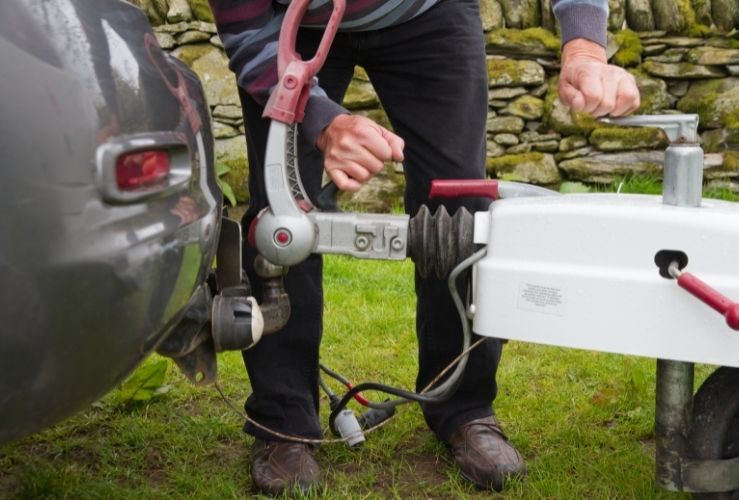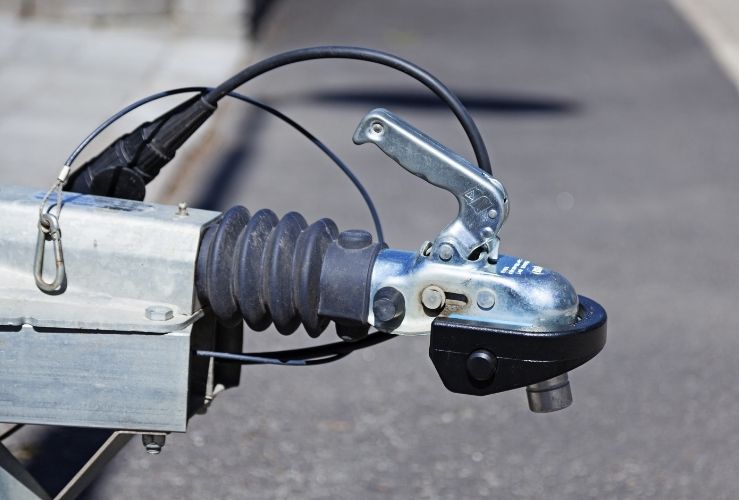If you’re planning a caravanning road trip, it’s important to know how to tow your caravan safely.
Towing a caravan with your car or SUV requires some planning to ensure you don't pose a risk to yourself, your passengers or other road users.
It's a good idea to understand what's involved in towing a caravan before you buy one. This will help reduce any worries about towing that might be putting you off from this rewarding pursuit.
You can even try caravan towing at some of the larger caravan shows - all under the watchful eye of an experienced instructor.
Caravan dealers may also let you practice towing a caravan before you buy.

Can I tow a caravan?
You will need to have the right driving licence for towing a caravan.
The categories of vehicle, including caravan and trailer size and how much weight you can drive/tow are listed on your licence.
Be aware that the rules changed back in 1997.
Driving tests passed BEFORE January 1 1997
If you passed before this date, you will probably be allowed to drive a vehicle and trailer to a Maximum Authorised Mass (MAM) of 8.25 tonnes (combined).
Driving tests passed AFTER January 1 1997
It's likely you'll only be able to drive 'category B' vehicles coupled with a caravan up to 750kg MAM, or a caravan over 750kg MAM assuming the MAM of the combined car and caravan is under 3500kg and the caravan's MAM is less than the empty or 'unladen' weight of the car.
What is a 'Category B' vehicle?
This is a vehicle weighing up to 3500kg MAM with up to 8 passenger seats, (exclusive of the driver's seat).
Here’s 5 of the best cars for towing.
The B+E car and trailer test
This test is taken at an LGV test centre as opposed to a regular driving test venue. It's booked in the same way as a normal practical test.
The test is taken in an unladen category B vehicle towing an unladen trailer weighing one tonne MAM or more, with suitable brakes.
Is vehicle tax required for caravans?
Unlike cars and vans, if your caravan is below a weight limit of 3,500kg then you will not require vehicle tax for your caravan.
These rules apply to touring caravans only. If you own a motorhome, or a caravan or trailer that is above these limits, you will be subject to certain road tax rules depending on the size of the vehicle.
Will my car insurance cover me for towing a caravan?
There is no legal requirement to insure a caravan.
As long as you have fully comprehensive car insurance, in most cases, this will usually provide some level of insurance for your caravan.
However, the cover provided by your car insurance will usually offer third party cover only.
With this in mind it is worth considering whether to invest some additional insurance cover specifically for your caravan, in order to pay for repairs or damage should they occur.
Need to fit a tow bar?
Find out how to fit a tow bar yourself.
We also have a helpful guide on how to choose a tow bar.

Getting ready to tow on the road
- Give yourself more time and space for all manoeuvres
- Aim to brake earlier than normal
- Know that you'll likely accelerate more slowly while towing a caravan
- You'll need to take corners more widely than usual due to the extra length of your 'outfit'
- Speed limits are lower while towing: 50mph on single carriageways; 60mph on dual carriageways
- You're not permitted to tow in the outside lane of a three-or-more lane motorway (unless told to do so by the relevant authorities)
- Use extension towing mirrors to ensure you have a good view behind your unit (it's a legal requirement)
- There should be no passengers in your caravan while it's being towed
- The caravan's number plate should show the registration of the tow vehicle (homemade plates are not allowed!)
- Pull over in a lay by if traffic builds up behind you - allowing it to pass
- Avoid causing an obstruction when parking
- Arrange suitable breakdown cover for your towing vehicle
Snaking and pitching
Snaking
'Snaking' is the term used when your caravan sways excessively. In extreme cases, the driver can lose control of the car.
Pitching
'Pitching' is the term used for vertical instability - the see-sawing motion observed when the caravan's front end moves up and down.
These phenomena can be scary - but shouldn't happen if the car and caravan are properly matched. Electronic and friction stabilisers - installed on many new caravans - help prevent snaking and pitching.
But even with the most suitable towing setup, passing vehicles may still cause air turbulence resulting in your car being pulled by your caravan.
In such a situation, reduce speed with your vehicle's engine braking and steer in a straight line. Attempting to solve the sway by steering can exacerbate the problem.

Safety checks to make before towing your caravan
You should always carry out some basic safety checks before towing a caravan to make sure that your vehicle and caravan are safe and legal.
Tow ball and connections
Check that:
- the trailer / caravan hitch is correctly coupled to the tow ball or pin - follow the manufacturer’s advice
- the coupling height is correct
- the 7 or 13 core cable and plug is not damaged
Wondering, what’s the difference between single and twin electrics when it comes to towbars? Here we explain.
Breakaway cable
Use a breakaway cable or secondary coupling.
The secondary coupling system or breakaway cable ensures that the caravan is stopped automatically should the primary coupling fail during towing.
Check that:
- the cable is not worn or damaged
- there’s enough slack in the cable so that it does not accidentally apply the car brakes
- the cable will not drag on the ground when you’re driving
Follow the manufacturer’s advice to make sure it’s connected correctly.
Understanding towing brackets
The towing brackets you use must be fixed with mounting brackets that have been recommended by the manufacturer, and must have been tested to UK or European standards.
If your car was first registered after 1 August 1998:
- Brackets must be 'type approved' and tested to European Directive 94/20/EC
- The bracket must display the type approval number together with the vehicle it has been approved for. This will be shown on a stamping, plate, or label
As regards towed trailers with a maximum mass of up to 1,500kg, the drawbar must not touch the road so that some residual steering is in place.
Wheels and tyres
Check that the tyres on both the car and caravan:
- do not have any cuts or bulges
- has a tread depth of at least 1.6mm:
- are inflated to the manufacturer’s specification for the load being carried
Lights and indicators
Check that there’s no damage to the lights or indicators, and that they’re all working correctly.
Load and weight limit
Check that:
- the car / caravan are not overloaded
- the load is distributed evenly
- the load is secure
You must ensure the towing vehicle and caravan are not overloaded in order to prevent:
- The caravan 'fishtailing' or swaying behind you
- Placing undue strain on your chassis and running gear
When both your car and caravan are loaded, the combined weight must not fall below the maximum 'train' weight of your car. You need to ensure a safe 'outfit' match between your car and your caravan.
Find out how much your loaded caravan weighs by visiting a local weighbridge, or by weighing everything separately and adding it to arrive at the caravan's 'Mass in Running Order' - or MRO.
Understanding towing weights: How much weight is safe for towing?
For safe towing, it's recommended that the weight of your loaded caravan does not exceed 85% of your car's kerb weight. Only those with a lot of experience towing caravans should consider going over this percentage.
It's critical to keep the weight of both your caravan and your car to a minimum. Place heavy objects close to the axle to keep the centre of gravity low. Don't be tempted to use storage space just because it's there.
Vehicles unrated for towing
Some vehicles may not have been rated for towing by the manufacturer. In such cases, the VIN plate will not show gross train weight, and there will not be any mounting points or the ability to have a tow bar installed.
If you're not sure if a vehicle is suitable for towing, contact the manufacturer for information.
Unbraked trailers
Some trailers are unbraked, which means there's a maximum tow weight (trailer and load combined) of 750kg, or 50% of the towing vehicle's kerbside weight (go by whichever is lower).
Whilst trailers weighing less than 750kg are not required by law to be fitted with braking systems, if a braking system is installed on a given trailer (of any weight), then it must be functioning properly - by law.
Correct function of braking systems is not possible for regular systems fitted to cars, especially in relation to the brake servo, which needs the engine to be running to function.
Maximum trailer width for towing
After April 2010, the maximum width for a trailer or caravan being towed in the UK increased to 2.55m (up from 2.3m before this) - applicable to cars/goods vehicles weighing under 3500kg.
The increase in allowed width brought the UK in line with the rest of Europe.
Towing a car using a car transport trailer
When it comes to towing a car behind a motorhome, the safest and easiest way is to use a car transport trailer.
So long as the towing vehicle's Maximum Permissible Towing Mass and Gross Train Weight are not exceeded, this is a completely legal option.
The car being towed (in effect a trailer) must have red triangular reflectors, and the number plate of the towing vehicle must be displayed on the rear of the 'trailer'.
Towing weights in depth
Tow car
Maximum Authorised Mass (MAM) must not be exceeded - this is the weight of the car fully laden (inclusive of passengers), plus any luggage, the tow bracket and the "nose weight" of the caravan.

What is a caravan’s nose weight?
Your caravan's nose weight is the downward force of its coupling head on your car’s tow ball. Generally, for towing stability this should be 5-7% of your caravan's laden weight.
Other terms for MAM are Maximum Permissible Weight (MPW) or Gross Vehicle Weight (GVW).
To meet legal requirements, the car and caravan's combined actual laden weight must not exceed the Gross Train Weight (GTW) – the maximum allowed combined weight of car and caravan, as specified by the car manufacturer.
Mass in Running Order (MRO) or Kerb Weight
These terms usually allow for the fuel tank to be 90% full, and the driver. However it does not include any load aside from standard equipment and tools, and the weight of the tow bracket.
Caravan weights
Maximum Technically Permitted Laden Mass (MTPLM)
A caravan's 'actual laden weight' must not exceed the Maximum Technically Permitted Laden Mass (MTPLM). This term is shown on the caravan's 'weight plate' and replaces the old 'gross weight' terminology.
MTPLM is sometimes called the Maximum Authorised Mass (MAM). MTPLM must not exceed the towing car's Maximum Permissible Towing Mass (MPTW).
MRO - Mass in Running Order
MRO - Mass in Running Order - is the caravan's standard factory spec unladen weight. MRO includes items such as gas bottles, hook-ups and batteries that before 2011 were considered part of the 'user payload'.
Ready to go?
Now you have a full understanding of how to tow a caravan and you’re ready to take to the open road.
Whether you’re heading off on a UK road trip or further afield somewhere like France, don’t forget to arrange breakdown cover for your car.
Want to know more about breakdown cover from Start Rescue?
See our Frequently Asked Questions section for answers to a wide range of common enquiries we have.




